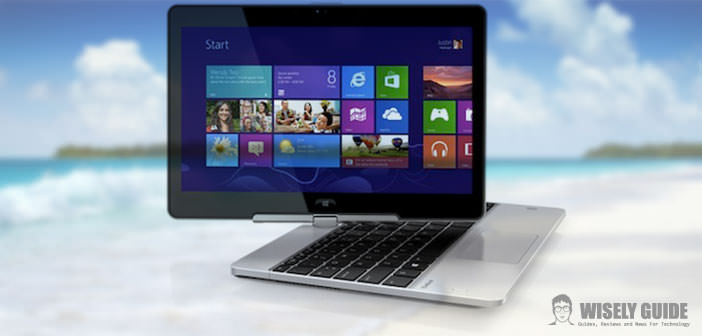HP EliteBook Revolve 810 is not only a tablet but – on the contrary – is undoubtedly a convertible notebook. And this just considered the form factor of Revolve, with a solid foundation with backlit keyboard, on which a single Central Point is grafted touch display, which can rotate 180 degrees (in one direction) and then lean on the base to use the Revolve 810, now yes, like a tablet.
The use of all the days that we did Revolve 810 has convinced us that we are faced with an ultra-valuable for professionals that combines performance with build quality but at a price much higher, given the configuration under test. HP EliteBook Revolve 810 is proof that with Windows 8, you can decline different form factor, similar in some ways, but so different in others, to the point of getting to products destined for a similar use, but at a dramatically different.
HP EliteBook Revolve 810 – Description and Specification
HP EliteBook Revolve 810 looks like a high-end ultra-light notebook that comes optimized to work with Windows 8 (we will try with Windows 8 Pro 64-bit), Revolve 810 is a device that retains a standard keyboard backlit leaves to user the possibility to replace the battery (6-cell polymer, now 44 W), which has a maximum of 8 hours, and is ready to fit into the normal working position thanks to the unique connector that serves as a hub for display, keyboard and mouse and any other peripherals. The high price is justified by the early configuration of merit and also on the quality of the materials.
HP EliteBook Revolve 810 has the aluminum chassis and magnesium alloy, is certified to MIL-STD 810G and all exposed surfaces in contact are significantly wheel to ensure a good grip, and the glass of the display is a great Corning Gorilla Glass second generation.
The total weight is 1.4 kg for a typical footprint of a solution with 11-inch display (21.2 x28x5x2, 22 cm maximum thickness). The frame of the display (UWVA HD LED-backlit 1366 x 768) offers a service to 720p webcam, dual microphone and light sensor.
It has support for data encryption through the embedded TPM chip. Revolve 810 does not have a login by fingerprint, but the solution using HP Face Recognition. HP has chosen to have a display port on the rear standard, two USB 3.0 ports (well spaced), the socket (that does not need, therefore, neither of adapters, or opening of flaps particular), the power connector.
The expansion of the memory is only through MicroSD (the drawer spring is positioned on the base and not visible). In addition to the standard connectivity WiFi (a / b / g / n) and Bluetooth, HP EliteBook Revolve 810 in some configurations (like ours) also integrated WWAN connectivity, but – quite unusual – not by Sim standard, but already using micro SIM.
Not only that, Revolve 810 supports Near Field Communication (NFC) and has a gyroscope and accelerometer sensor and GPS. The left profile is completely free on the right-hand space is the single headphone and microphone socket and the socket of the dock, in addition to the volume control, the power button and a button for locking the display rotation.
Our model came equipped with an Intel Core i7 third generation (not Haswell) in his model 3687U with integrated Intel HD 4000. Core i7 3687U is a dual-core CPU clocked at 2.1 GHz 4 MB of level three caches. The basic configuration would have 4 GB of Ram, on the other hand. We have found our model fitted with 8 to 1.6 GHz. The storage is also enhanced with the most capacious SSD 256 GB.
HP EliteBook Revolve 810 – Performance.
We have completed testing Work and Home PC Mark 8 Futuremark with 810 Revolve: The Fund has earned 4516 points and Work Home in 2972, as far as creativity is the Creative 2662 Score, with the excellent score of Storage in 4869 with a bandwidth of 173 Mbytes per second. It is a real strength, along with 8 GB of Ram. They are also more than gratifying performance indicators of Windows.
The fund remains weak from that chart with 5.6 (which marked the final score down) and 6.4 respectively for the entry Graphics and Gaming Graphics. Regarding the main disk, the solution from 256 Gbyte deserved 8.1, the processor 7.2 and 7.5 the Ram. Overall, the machine is brilliant for all office jobs, but not suitable for the game. It would be really much more interesting for performance analysis of Revolve 810 with the new Haswell processors.
While facing a solution ultraportable, we observe that it was not for nothing sacrificed the overall ergonomics. In addition to the keyboard, very good, except for the top row of function keys, which does not appear to be very stable, even the touchpad is very sensitive and responsive. We were more amazed by the renunciation of support for SD memory cards, the most widely used by cameras, while the microSD are the classic solution for smartphones.
An idea that this could also facilitate the exchange of photos between smarpthone and notebooks (maybe appreciated by business users), but that we do not prefer. Well instead the integration of support for WWAN connectivity, but not all chipsets are available in different configurations support LTE. It meets the location of WLAN antennas at the base of the display and the WWAN on the upper profile. NFC support is located in the rear of the base.



